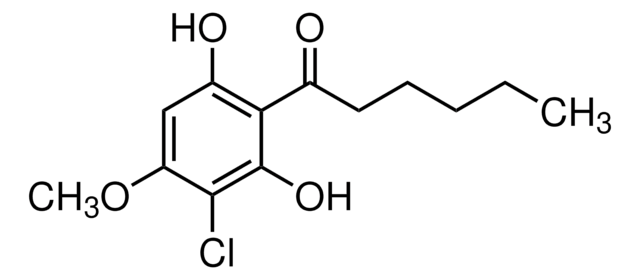SML0599
DIF-1
≥98% (HPLC)
Sinónimos:
1-(3,5-Chloro-2,6-dihydroxy-4-methoxyphenyl)-1-Hexanone
About This Item
Productos recomendados
Análisis
≥98% (HPLC)
formulario
powder
color
white to beige
solubilidad
DMSO: 20 mg/mL, clear
temp. de almacenamiento
2-8°C
InChI
1S/C13H16Cl2O4/c1-3-4-5-6-7(16)8-11(17)9(14)13(19-2)10(15)12(8)18/h17-18H,3-6H2,1-2H3
Clave InChI
VUDQSRFCCHQIIU-UHFFFAOYSA-N
Acciones bioquímicas o fisiológicas
Differentiation-inducing factor-1 (DIF-1) blocks the migration and invasion of cells and decreases the expression of matrix metalloproteinase-2. It prevents the proliferation of cells using glycogen synthase kinase-3 (GSK-3)-dependent mechanism. DIF-1 is more active when compared to DIF-2 in promoting stalk cell differentiation under submerged assay conditions.
Código de clase de almacenamiento
11 - Combustible Solids
Clase de riesgo para el agua (WGK)
WGK 3
Punto de inflamabilidad (°F)
Not applicable
Punto de inflamabilidad (°C)
Not applicable
Certificados de análisis (COA)
Busque Certificados de análisis (COA) introduciendo el número de lote del producto. Los números de lote se encuentran en la etiqueta del producto después de las palabras «Lot» o «Batch»
¿Ya tiene este producto?
Encuentre la documentación para los productos que ha comprado recientemente en la Biblioteca de documentos.
Nuestro equipo de científicos tiene experiencia en todas las áreas de investigación: Ciencias de la vida, Ciencia de los materiales, Síntesis química, Cromatografía, Analítica y muchas otras.
Póngase en contacto con el Servicio técnico








